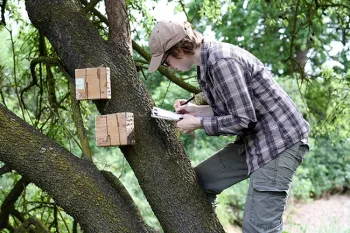
In a newly published article titled, “Flower Plantings Support Wild Bee Reproduction and May Also Mitigate Pesticide Exposure Effects,” in the Journal of Applied Ecology, the eight-member team related that "to address the potential of flower plantings to mitigate bee pesticide exposure and effects and support bee reproduction, we established replicated sites where half contained flower plantings. We used sentinel bees to assess nesting and reproduction, quantified local and landscape flower availability, and used bee-collected pollen to quantify bee pesticide exposure and forage resource use. We asked the following questions:
- To what extent do bees use flower plantings?
- Do flower plantings promote bee reproduction?
- Do flower plantings modify bee pesticide exposure and effects on reproduction?"

The paper is the work of co-lead authors Maj Rundlöf and Clara Stuligross, and co-authors Arvid Lindh, Rosemary Malfi, Katherine Burns, John Mola, Staci Cibotti and Professor Williams.
Their abstract:
- Sustainable agriculture relies on pollinators, and wild bees benefit yield of multiple crops. However, the combined exposure to pesticides and loss of flower resources, driven by agricultural intensification, contribute to declining diversity and abundance of many bee taxa. Flower plantings along the margins of agricultural fields offer diverse food resources not directly treated with pesticides.
- To investigate the potential of flower plantings to mitigate bee pesticide exposure effects and support bee reproduction, we selected replicated sites in intensively farmed landscapes where half contained flower plantings. We assessed solitary bee Osmia lignaria and bumble bee Bombus vosnesenskii nesting and reproduction throughout the season in these landscapes. We also quantified local and landscape flower resources and used bee-collected pollen to determine forage resource use and pesticide exposure and risk.
- Flower plantings, and their local flower resources, increased O. lignaria nesting probability. Bombus vosnesenskii reproduction was more strongly related to landscape than local flower resources.
- Bees at sites with and without flower plantings experienced similar pesticide risk, and the local flowers, alongside flowers in the landscape, were sources of pesticide exposure particularly for O. lignaria. However, local flower resources mitigated negative pesticide effects on B. vosnesenskii reproduction.
- Synthesis and applications. Bees in agricultural landscapes are threatened by pesticide exposure and loss of flower resources through agricultural intensification. Therefore, finding solutions to mitigate negative effects of pesticide use and flower deficiency is urgent. Our findings point towards flower plantings as a potential solution to support bee populations by mitigating pesticide exposure effects and providing key forage. Further investigation of the balance between forage benefits and added pesticide risk is needed to reveal contexts where net benefits occur.
Journal of Applied Ecology, a publication of the British Ecological Society, publishes novel, high-impact papers on the interface between ecological science and the management of biological resources.

